This homemade pizza sauce is great on any pizza, but it’s really made to be enjoyed on thin-crust pizzas. Since you’ll only get a little bit on each slice of pizza you eat, it is intensely flavored with both canned tomatoes and tomato paste.
With a little zing from pepper flake and red wine vinegar, the robust flavor stands out, and cooking it reduces the liquid so your thin-crust pizza doesn’t get soggy.
You’re going to win pizza night with this easy pizza sauce recipe, I promise.
For deep-dish pizzas, try my grandma pizza dough recipe, and for thin crust, you can’t beat my easy pizza dough.
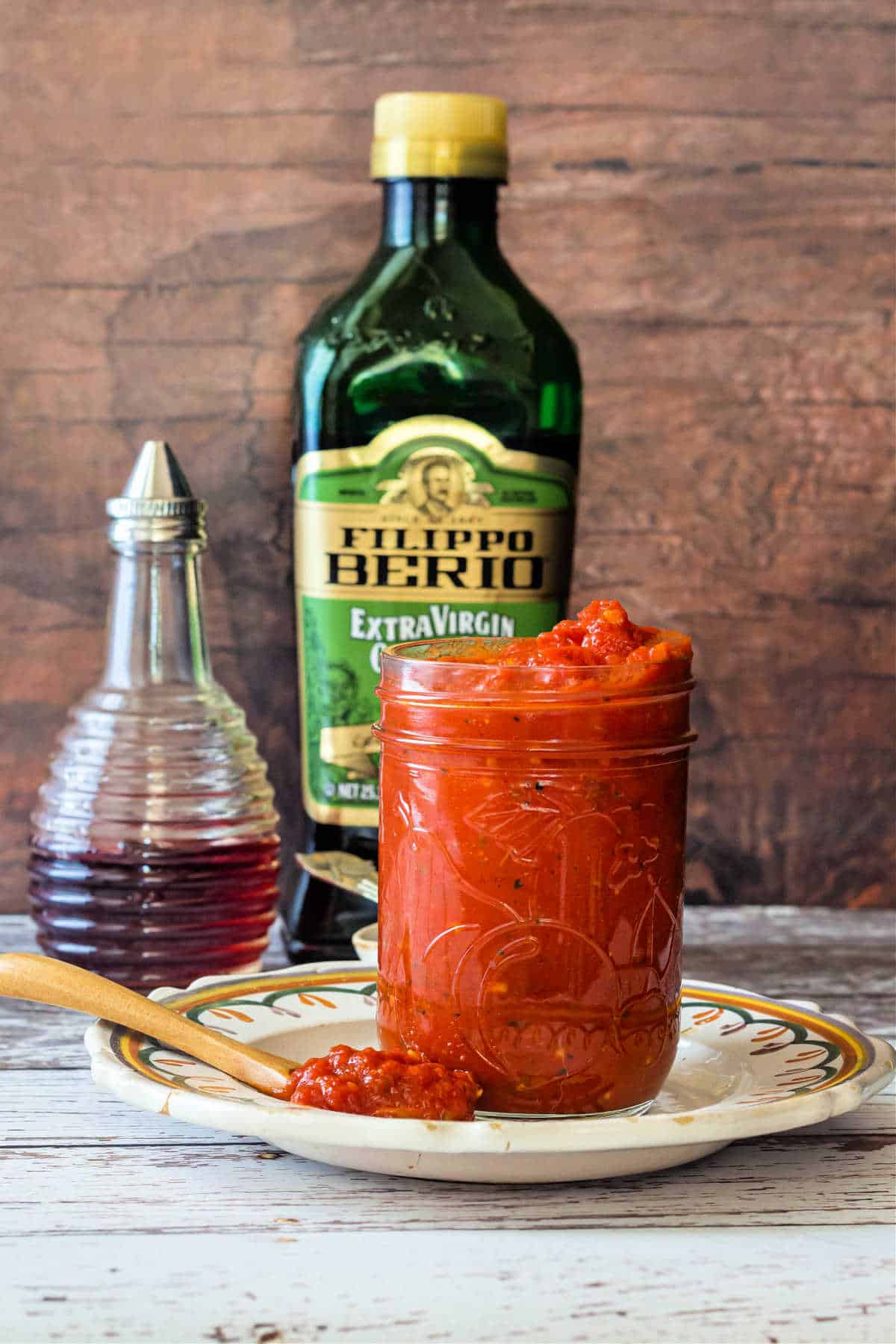
View my best homemade pizza sauce recipe web story here.
Homemade Pizza Sauce, at a Glance
✅Skill Level: Beginner
✅Skills: Infusing oil, sweating onions, simmering
✅Type: Pizza sauce
✅Number of Ingredients: 12
✅Prep Time: 5 minutes
✅Cook Time: 30 minutes
✅Yield: 3 cups, enough for 6 12″ pizzas
Jump Straight to the Recipe
Why You Need to Make This Pizza Sauce
I am generally a proponent of fresh pasta sauce: a few ingredients stirred together, uncooked, that cook and intensify while the pizza bakes.
Pastry Chef Online Participates in Affiliate Programs. If you make a purchase through one of my links, I may earn a small commission. For more information click to read my disclosure policy
This type of sauce works really well for something like Sicilian, Detroit, or other deep-dish pizzas.
But for a thin-crust pizza that generally cooks in under 10 minutes, a cooked sauce is the way to go.
This sauce is a great option because it is well-balanced, it’s intensely flavored, and it’s simmered long enough that much of the liquid evaporates.
Reducing the amount of liquid in a sauce intensifies the flavors, which is always a good thing. It also keeps your crust from getting soggy, which is also a good thing.
This is an easy pizza sauce you can make with all pantry staples, so you most likely already have most everything on hand that you’ll need.
How To Make It
First, we’ll look at ingredients as well as substitutions.
Then, I’ll walk you through the steps to make the sauce, give you some equipment recommendations, and also provide some ways to vary the sauce to your taste.
Ingredients and Substitutions
Here’s what you’ll need to make it:
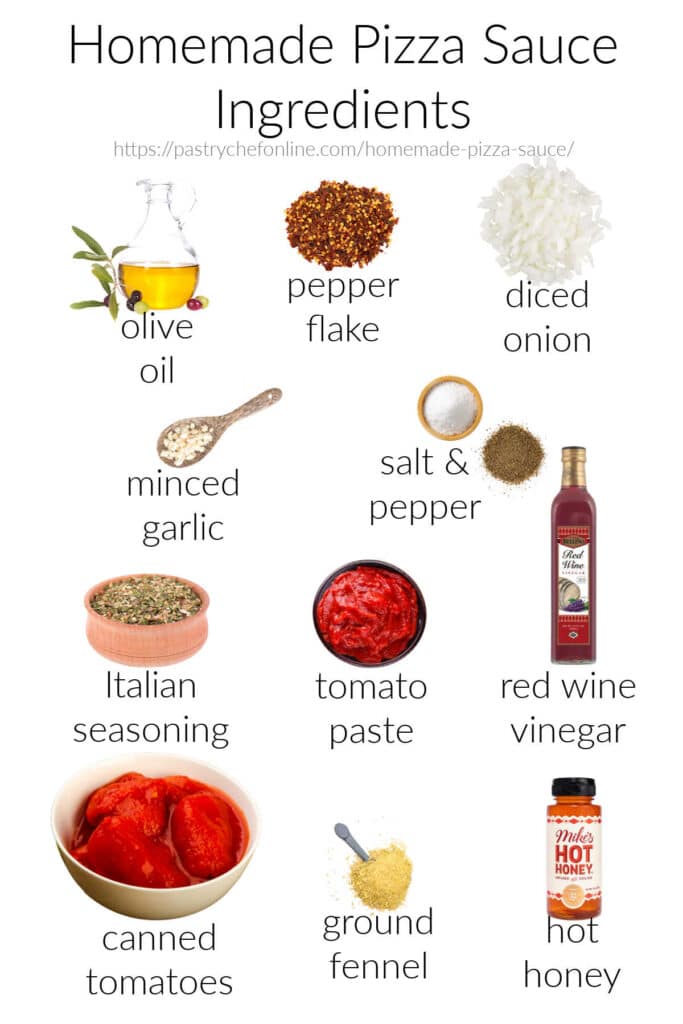
- Olive oil: Carries flavor and adds some richness and silkiness to the sauce. It also is the medium for frying the base flavors. For a smoky layer of flavor, use bacon fat instead of olive oil.
- Pepper flake: Brings a little heat. Use more or less, or leave it out entirely if you prefer
- Salt and pepper: Salt brings out all the flavors, counteracts any bitterness from the tomatoes, and brings dimension to your pizza sauce. I am a fan of the pungency of black pepper. If you are too, go heavy on it. If not, you can leave it out.
- Italian seasoning: Is it authentically Italian? No. No it’s not. But it is easy to find and is generally delicious. If you don’t have Italian seasoning or don’t want to use it, use dried oregano, thyme, and a few leaves of fresh basil
- Onion: Use sweet onion, white onion, or yellow onions. I call for 1/2 a medium onion, which is entirely dependent on what you think a medium onion looks like. Don’t lose any sleep over it, though. If you think your onion is super big, just use 1/4 of it. If all you have is onion powder, use that. Maybe 1-1 1/2 teaspoons
- Garlic: I used pre-minced because I had some, and I am a little lazy. Feel free to use fresh, and use as much as you would like. I used about 3 cloves worth. Use garlic powder if you’d like or if that’s what you have. 1/2-1 teaspoon
- Tomato paste: Adds intense tomato flavor. It also caramelizes a little during the cooking process, bringing extra depth of flavor to your sauce.
- Canned whole tomatoes: Canned plum or San Marzano is preferred, but there is no reason not to use what you have, whether diced, crushed or whole. You’ll need 1 large can (28 oz). Only use fresh tomatoes if they are very ripe and in season, and blanch them so you can slip the skins off before adding to your sauce
- Red wine vinegar: Brightens the flavor and brings a little “sparkle” to your sauce. Substitute any vinegar: apple cider, white wine vinegar, etc. If you like your sauce to be a bit on the sweeter side, use balsamic vinegar
- Ground fennel (optional): This is not a usual ingredient found in pizza sauce, but stick with me. Fennel is one of the flavorings used in Italian sausage. I consider it the defining flavor, and I love it. So I use a bit of ground fennel in my sauce to bring a bit of “sausage-i-ness.” It also lifts the flavor a bit. It’s kind of hard to describe, but it is just so good. As an aside, I also sprinkle any pizza, either homemade, store-bought, or frozen, with some ground fennel to finish before serving.
- Hot Honey: This is a newer addition to my recipe, and it’s a great way to bring a bit of sweet/tang/zing all at the same time. So good!
Jenni Says: If substituting onion powder and garlic powder, add to the infused oil and let sizzle for about 30 seconds before proceeding with the recipe as written.
Procedure
The procedure for making this recipe is fairly straightforward.
Technically, you could put everything in a pot, boil it for 30 minutes or so, and be done.
But with a couple of extra steps, you’ll be able to bring as much flavor to this intensely tomato-y sauce as possible.
Here’s how it goes:
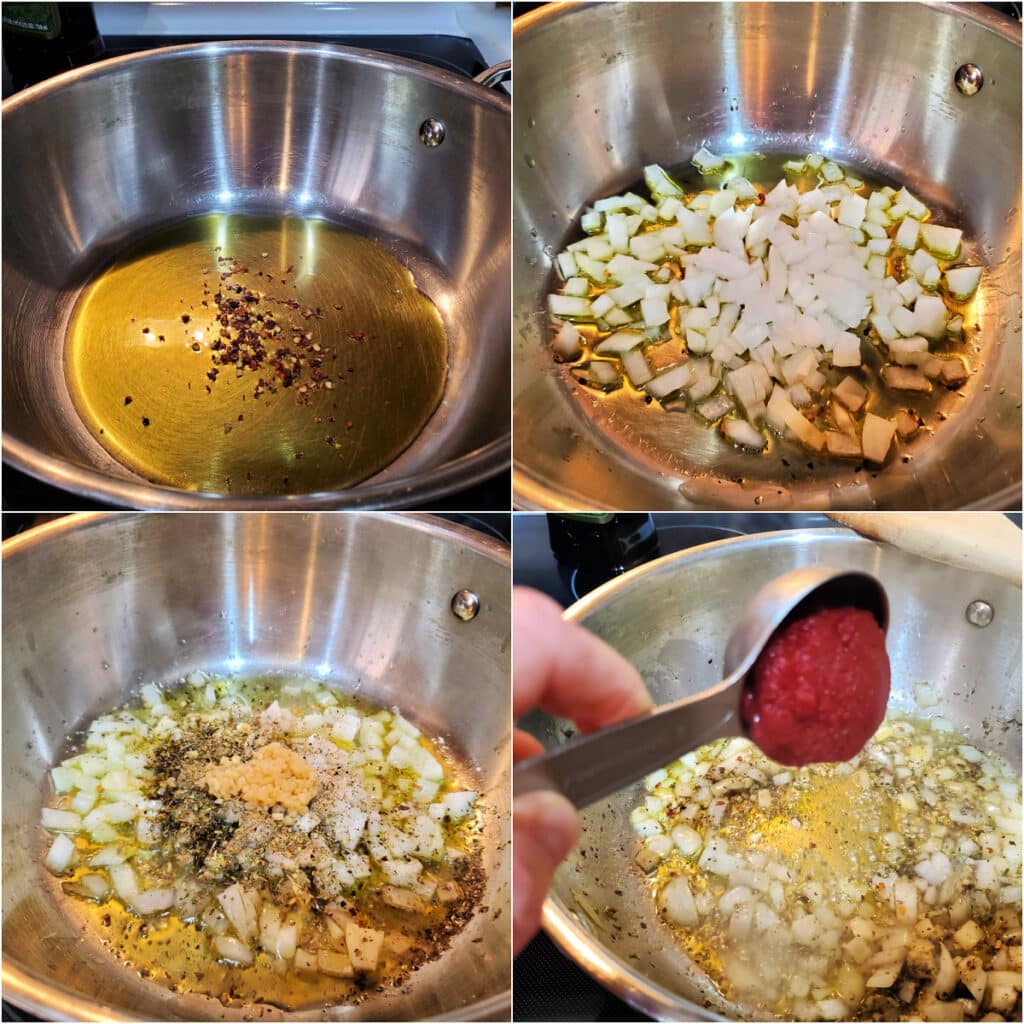
- Let pepper flake infuse the oil for 30 seconds or so.
- Add onion, garlic, salt, pepper, and Italian seasoning. Cook for 3-4 minutes until onions start to soften.
- Add tomato paste, stir it in well, and then let everything “fry” in the oil for a minute or so. This will caramelize the tomato sauce and bring a ton of extra flavor to your sauce.
- Add the tomatoes and vinegar. Break up tomatoes with a meat chopper, spoon, or spatula.
- Stir in the ground fennel, and simmer for about 20 minutes, until the sauce is nice and thick.
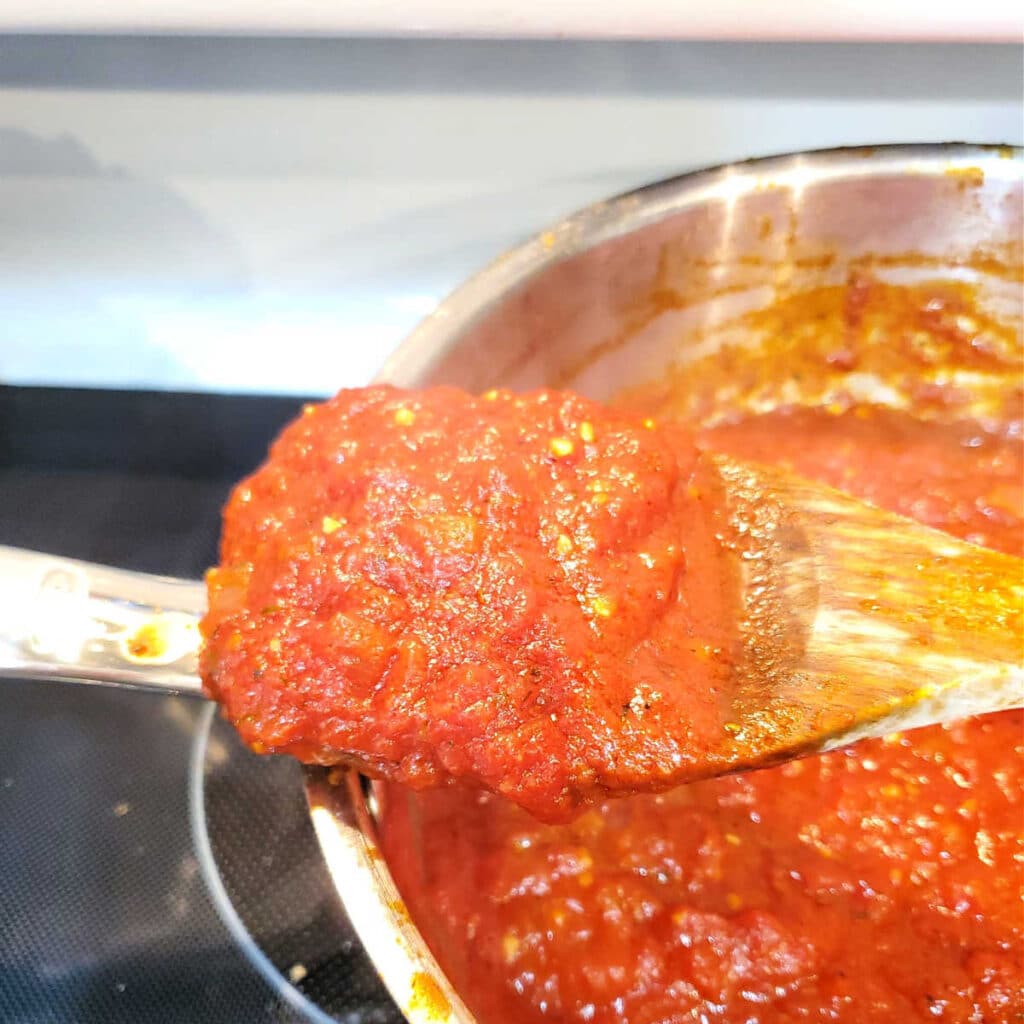
Note that your sauce is thick enough when you can mound it up on a wooden spoon. It should not be runny but rather thick and a little “gloppy.”
Equipment You May Need
Other than a heavy-bottomed saucepan and a spoon for storing, you really don’t need a lot of specialized equipment.
I do like to use my meat chopper for breaking up the tomatoes into a chunky sauce.
For a smoother sauce, you could pulse it in a food processor or run it through a food mill on the coarse or medium disc.
Tips for Success
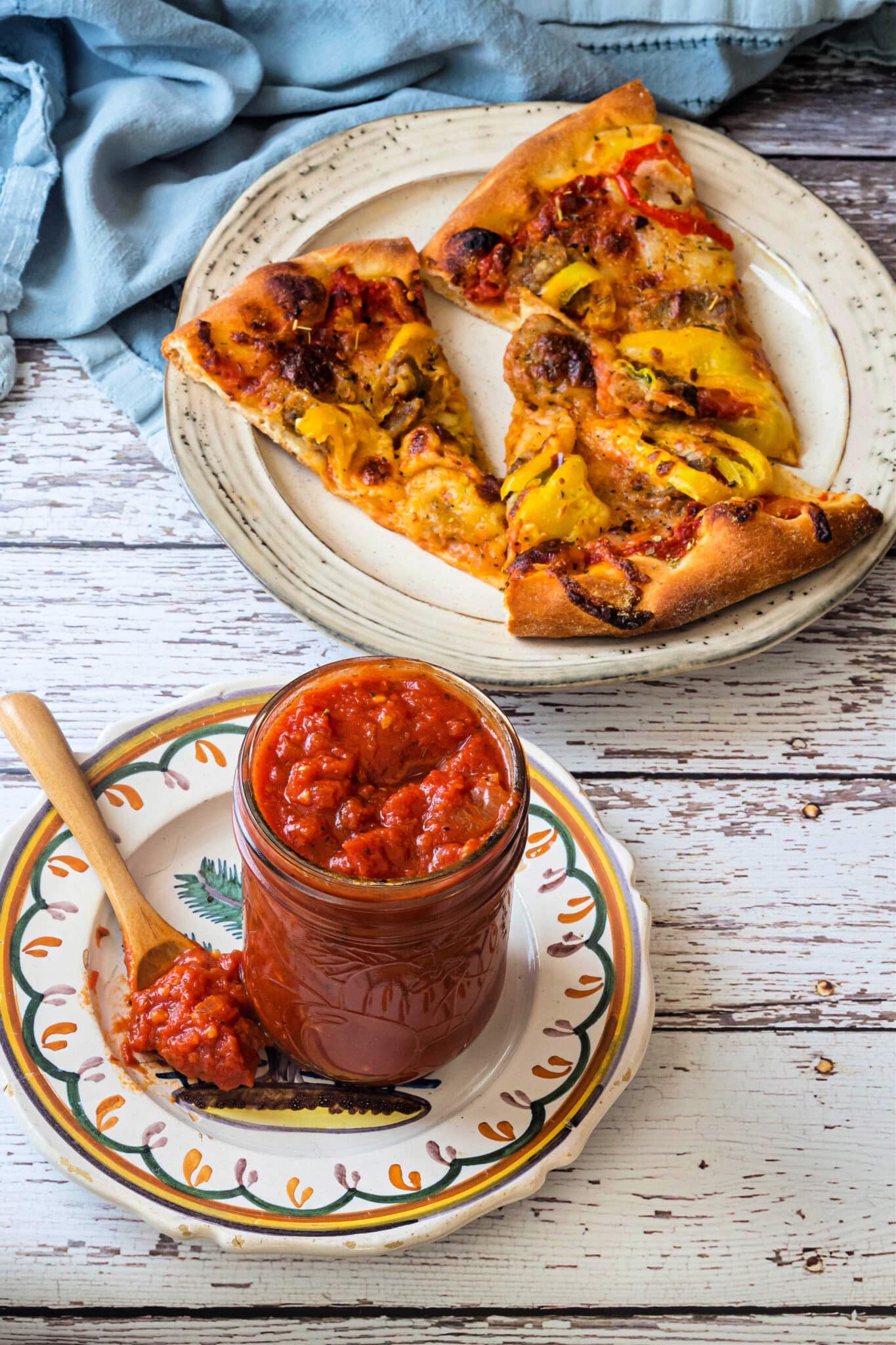
Take the time to fry the tomato paste in olive oil. It brings a whole extra layer of flavor to your pizza sauce that you wouldn’t otherwise get.
Don’t rush cooking the sauce. Simmer until it is is fairly thick. Otherwise, your pizza could end up soggy. So if yours still seems a little thin after 20 minutes, keep simmering until it is nice and thick.
Add the red wine vinegar to the empty tomato can rather than to the pot. Then, swirl the vinegar around in the can to get all the tomato sauce of the sides, then pour that into your pot.
Homemade Pizza Sauce Q & A
It is, and it’s also vegan as written.
Keep the sauce in a tightly covered container for up to a week in the fridge. For longer storage, freeze in 1/2 cup portions (enough for 1 pizza) and store in a tightly-sealed, zip-top freezer bag for up to 3 months.
Yes, you absolutely can. The flavor will continue to concentrate with the longer cooking time which yields a more intensely-flavored sauce.
Serving Suggestions
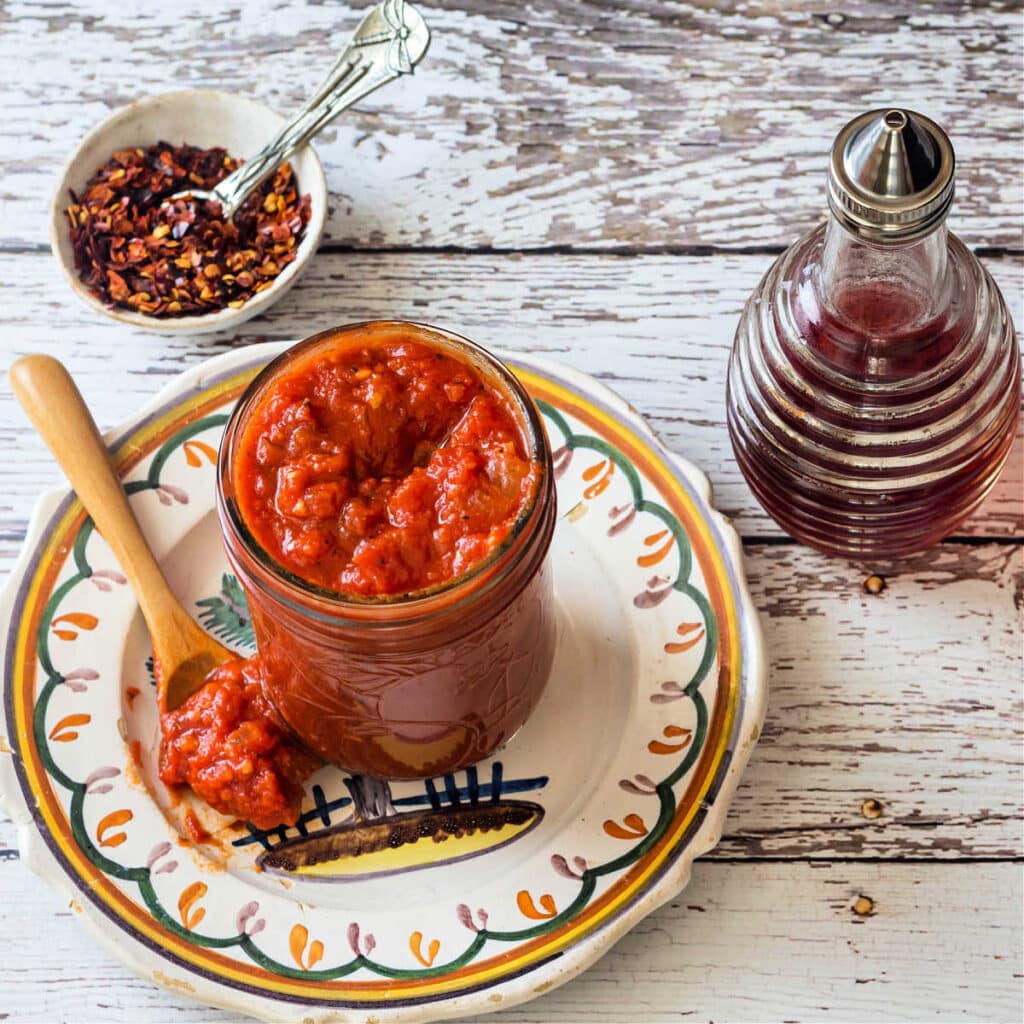
The most obvious use of this sauce is to make a pizza, y’all. Or multiple pizzas.
You could use it as a sauce for my lasagna pizza or slather it on grandma pizza dough before adding your toppings.
It is also a great dipping sauce for fried mozzarella sticks or polenta fries, or serve it alongside (or spread on top of spaghetti pie.
Add some easy, weeknight meatballs and serve this as spaghetti and meatballs (you may need to add some pasta cooking water to the sauce to thin it a bit) or dunk some air fryer mushrooms.
Questions
If you have any questions about this post or recipe, I am happy to help.
Simply leave a comment here and I will get back to you soon. I also invite you to ask question in my Facebook group, Fearless Kitchen Fun.
If your question is more pressing, please feel free to email me. I should be back in touch ASAP, as long as I’m not asleep.
A Note About Measurements
My recipes are almost all written by weight, including liquids, unless otherwise specified.
For accuracy and consistency of results, I encourage you to buy–and use–a kitchen scale.
I promise that baking and cleanup will be so much quicker and easier.
This is the scale that I recommend for home use. I have owned and used one for years.
Don't let its small price and small size fool you. The Escali Primo is an accurate and easy-to-use food scale that I have used for years. It's easy to store, easy to use, has a tare function, and easily switches between grams and ounces/pounds for accurate measurements.
Did You Make This? Please Leave a Rating and Review!
It will help me and other readers so much if you take a moment to rate and leave a review for this recipe.
You can use the stars to rate 1-5 (5 is best), and leave a review in the comments. It helps me make adjustments if any are needed, and comments help others decide whether the recipe is worth making.
Other ways to share include pinning, and/or sharing on your favorite social media platform.
Thank you so much for taking the time!

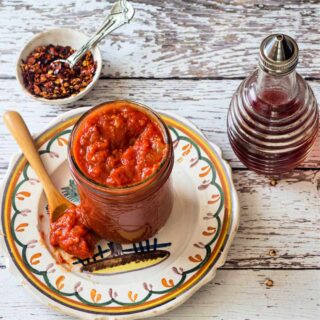
Homemade Pizza Sauce
Ingredients
- 2 Tablespoons olive oil
- 1/4-1/2 teaspoon pepper flake depending on how spicy you like things
- ½ medium sweet or white onion finely diced
- 3 cloves garlic minced
- ¾ teaspoon kosher salt I use Morton’s
- several grindings of black pepper
- 1 ½ teaspoons Italian seasoning crushed lightly in your palm
- 2 Tablespoons tomato paste
- 1 28 oz can whole tomatoes preferably Roma/San Marzano
- 2 Tablespoons red wine vinegar
- ½ teaspoon ground fennel optional
- 2-3 teaspoons hot honey optional, for a bit of extra sweetness and zing
Instructions
- Heat a medium saucepan over medium-high heat.
- When hot, add the olive oil and the pepper flake.
- Stir for about 30 seconds to infuse the oil with peppery goodness.
- Add the onion, garlic, salt, pepper, Italian seasoning and cook for about 3 minutes just to soften the onions.
- Add the tomato paste and stir it in well, allowing the paste to "fry" for maybe 15 seconds in the pan.
- Pour in the tomatoes and their liquid.
- Pour the vinegar into the tomato can and swirl it around to thin out the tomato liquid, then pour it into your sauce.
- Break up with tomatoes with the back of a wooden spoon or use a meat chopper (that's what I used).
- Bring the sauce to a boil and then reduce to a simmer.
- Simmer for about 20 minutes, stirring fairly frequently.
- Finish with a squirt of hot honey, if desired. I love the addition, because hot honey is a mixture of honey (floral sweet), vinegar (acidity/brightness), and peppers of some sort (heat). It's a great combo to finish a sauce!
- Taste and adjust seasonings if necessary.
- Cool and store in the fridge for a week or freeze in 1/2 cup portions for up to 3 months.
Did You Make Any Changes?
Nutrition
Thanks for spending some time with me today.
I hope you enjoy your next pizza night. You’re gonna wow everyone with your homemade pizza sauce!
Take care, y’all.

Hi, y’all! I hope you’ve enjoyed this post and hopefully also learned a thing or two.
If you like my style, I invite you to sign up for my occasional newsletter, The Inbox Pastry Chef.
Expect updates on new and tasty recipes as well as a bit of behind-the-scenes action. I hope to see you there!


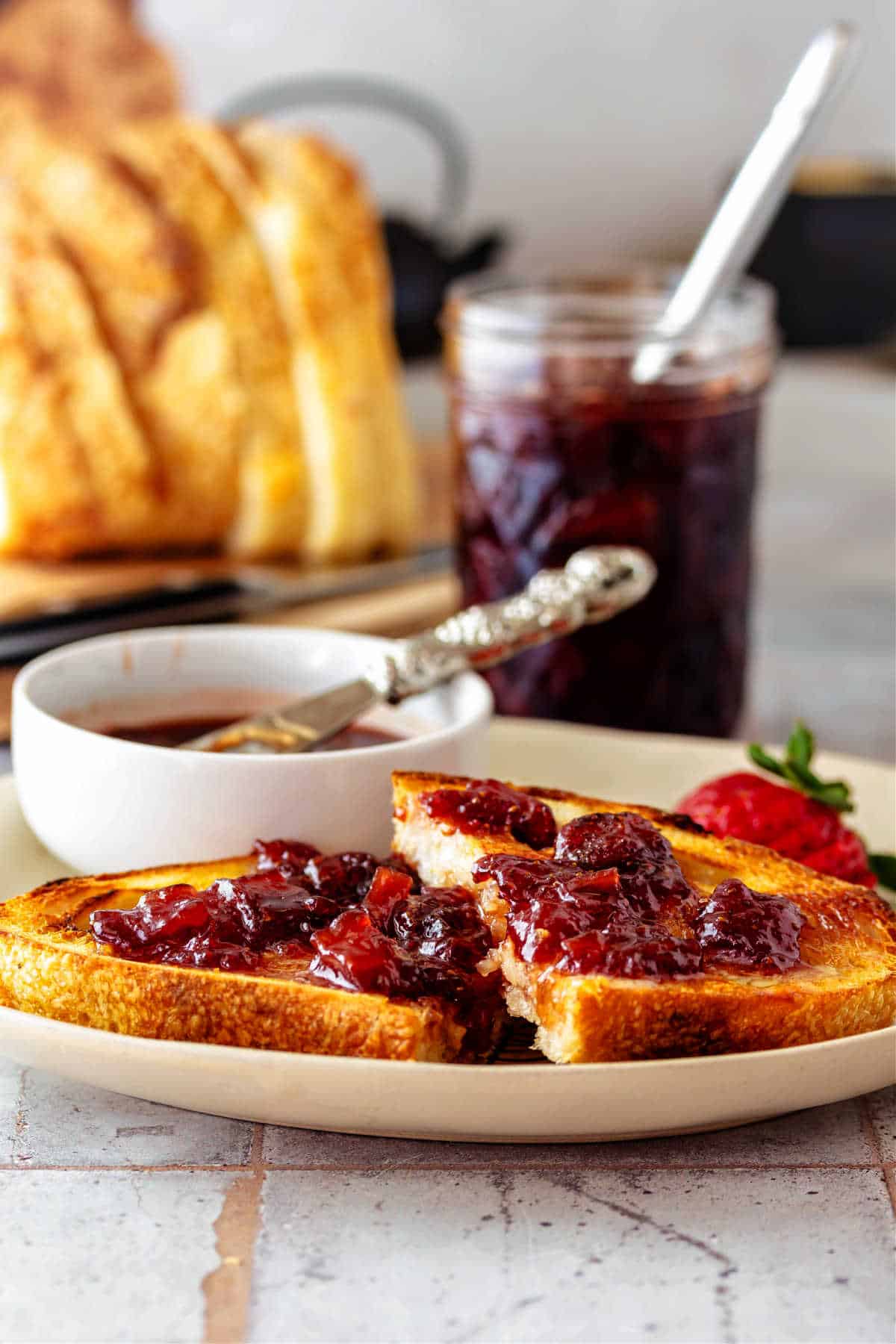
Join in Today!
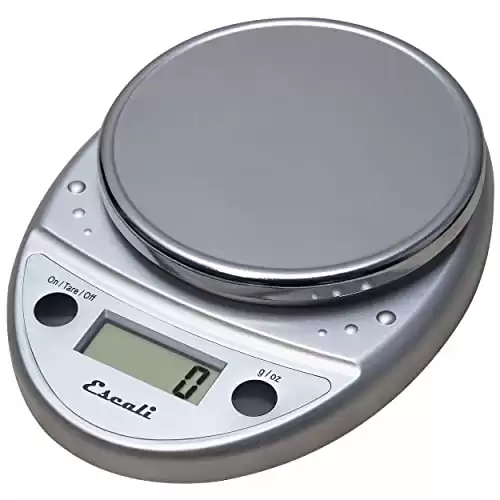
Fabulous for flatbread party snacks. Everyone loved it!
I’m so glad y’all enjoyed it, Carolyn! Thanks for letting me know. I appreciate the feedback!
hallo ik probeer soms eens een gerechtje maar ik heb zo problemen met de oz om te rekenen bij ons is het gram kilogram of liters en milliliters en das voor mij wat moeilijker maar ik wil je wel bedanken voor de zalige resepten en de pizzas ga ik zeker proberen
Yes, the conversions can be tricky. Here in the US, our scales switch between grams and ounces at the touch of a button. An ounce US weighs, 28 grams, so to convert, multiply my ounce measurements by 28 and you will be good to go. I’m glad you enjoy the recipes. Thank you for being here, Saskia!
Oh.Jenni,, your pizza sauce sounds like my spaghetti sauce, yummy. I use Hunts stewed tomatoes so I don’t have to work on them. And try some garlic infused EVOO instead of the vinegar sometimes, I tell you what, I don’t know where my kitchen would be without it. Happy Cooking!
Thanks for the tip, Jennifer! A friend just sent us a 3-pack of flavored oils for Christmas, and I am very much looking forward to trying them out in all kinds of recipes, including the pizza dough and pizza sauce!